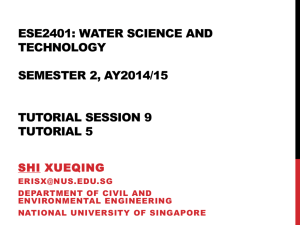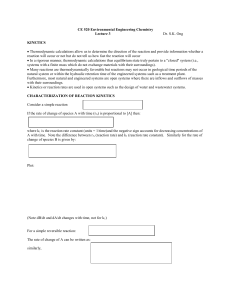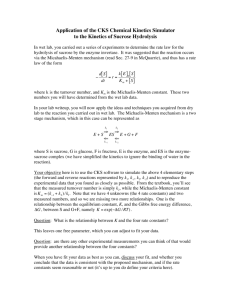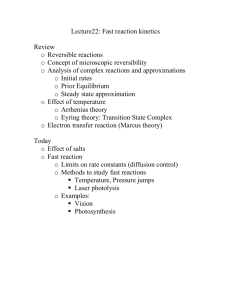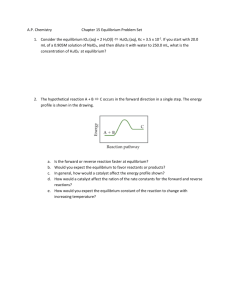Reaction Kinetics - Clarkson University
advertisement
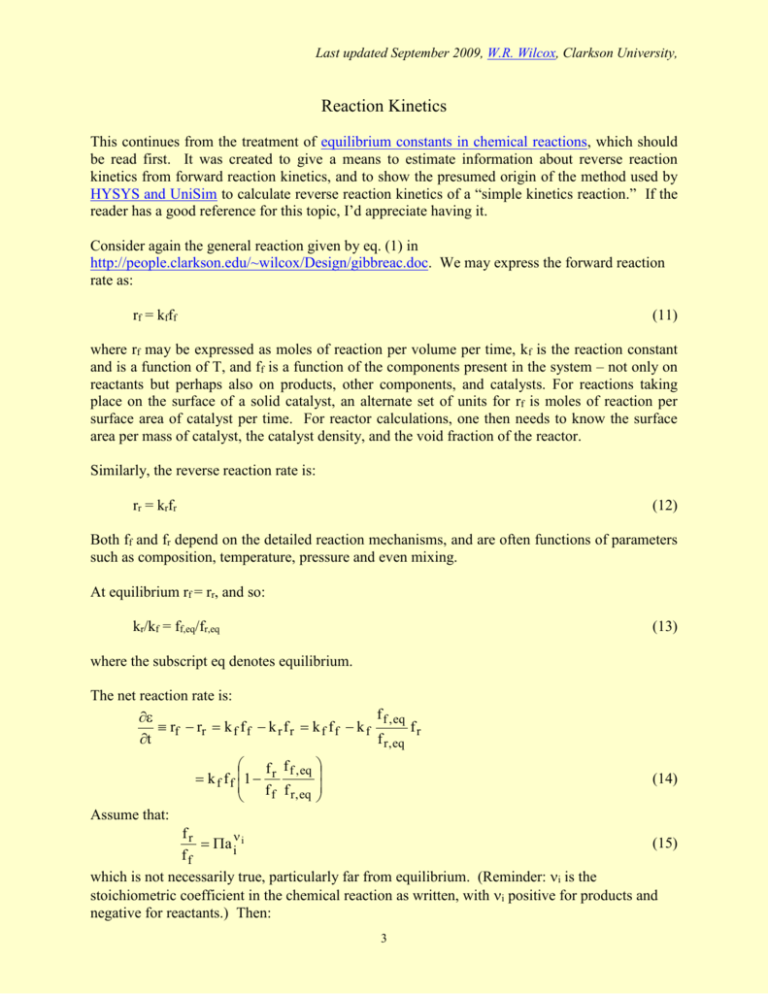
Last updated September 2009, W.R. Wilcox, Clarkson University, Reaction Kinetics This continues from the treatment of equilibrium constants in chemical reactions, which should be read first. It was created to give a means to estimate information about reverse reaction kinetics from forward reaction kinetics, and to show the presumed origin of the method used by HYSYS and UniSim to calculate reverse reaction kinetics of a “simple kinetics reaction.” If the reader has a good reference for this topic, I’d appreciate having it. Consider again the general reaction given by eq. (1) in http://people.clarkson.edu/~wilcox/Design/gibbreac.doc. We may express the forward reaction rate as: rf = kfff (11) where rf may be expressed as moles of reaction per volume per time, kf is the reaction constant and is a function of T, and ff is a function of the components present in the system – not only on reactants but perhaps also on products, other components, and catalysts. For reactions taking place on the surface of a solid catalyst, an alternate set of units for rf is moles of reaction per surface area of catalyst per time. For reactor calculations, one then needs to know the surface area per mass of catalyst, the catalyst density, and the void fraction of the reactor. Similarly, the reverse reaction rate is: rr = krfr (12) Both ff and fr depend on the detailed reaction mechanisms, and are often functions of parameters such as composition, temperature, pressure and even mixing. At equilibrium rf = rr, and so: kr/kf = ff,eq/fr,eq (13) where the subscript eq denotes equilibrium. The net reaction rate is: f f , eq rf rr k f f f k r f r k f f f k f fr t f r , eq f k f f f 1 r ff f f , eq f r , eq (14) Assume that: fr (15) a i i ff which is not necessarily true, particularly far from equilibrium. (Reminder: i is the stoichiometric coefficient in the chemical reaction as written, with i positive for products and negative for reactants.) Then: 3 f r , eq f f , eq Ka (16) i.e., the equilibrium constant (see equation (5)). Substituting equations 15 and 16 into 14 we obtain: a i i rf rr k f f f 1 Ka (17) rr k f f f a i i Ka krfr (18) from which: kr kf and f r f f a i i Ka (19) Reminder: This is not necessarily true, but may nevertheless be useful if you have no better information. It does have the distinct advantage of not permitting the reaction to go beyond equilibrium, which is impossible thermodynamically. That is, one would expect it to be true near equilibrium. Let us now consider how one would enter these results into HYSYS/UniSim’s reaction kinetics for a “Kinetics reactor,” which uses the following forms for the forward and reverse reaction kinetics: E k A exp T RT (20) E ' ' k ' A ' exp T RT (21) where the unprimed parameters are for the forward reaction and the primed quantities for the reverse reaction. Thus k kf and k' kr. In HYSYS/UniSim, A and A', E and E', and ' are taken to be constant and independent of pressure and temperature. What we desire is the values of the primed constants given the unprimed constants. First we consider the case where the reactants and products are all gases and form an ideal gas mixture. Let us assume that we are using partial pressures pi for the forward reaction rate expression and that we have already obtained Kp versus T, plotted ln(Kp) versus 1/T, and fit a straight line to the data to obtain the slope of -H0/R and intercept of S0/R. Then, taking the exponential of equation (9) in the equilibrium constants writeup, we have: H 0 S0 K p exp R RT (22) 4 Substituting equation 22 into 19 and comparing with 21, we see by comparing like terms that: f r f f p i i ; = '; A' = A exp(-S0/R); and E' = E - H0 (23) Thus we have obtained the desired values of the constants for the reverse reaction. Things are more complicated for an ideal-gas mixture if the reaction kinetics basis is molar concentrations Ci rather than partial pressures. We make the equivalent assumption to that above, f r , eq fr KC Ci i so that f f , eq ff (24) Substituting equations (24) and (10) into (17), we obtain: rr A' e E' / RT ' T kf ff C i i KC 0 0 Ae E / RT T f f C i i e H / RT e S / R RT i (25) Note that we have again assumed that a plot of ln(Kp) versus 1/T has been fit to a straight line. Collecting concentration dependent terms we see that f r f f Ci i . From terms that depend neither on concentration nor on temperature, A' AR i e S 0 /R bar i . From terms that depend on T to a power, ' i . From terms that depend on the exponent of 1/T, E' = E H0. Thus when the number of moles of ideal-gas product equals the number of moles of reactants, i = 0 and we have the same result as previously, as would be expected because then KC = Kp. In HYSYS/UniSim’s “Simple Rate reactor” the constants for K are entered specifically. Care must be taken that if concentrations are used for the basis, then it is KC that must be used with KC versus T fit to the form ln(K) = A + B/T + Cln(T) + DT using multiple linear regression analysis (see Excel tutorial or MATLAB tutorial for instructions on how to do this). 5
